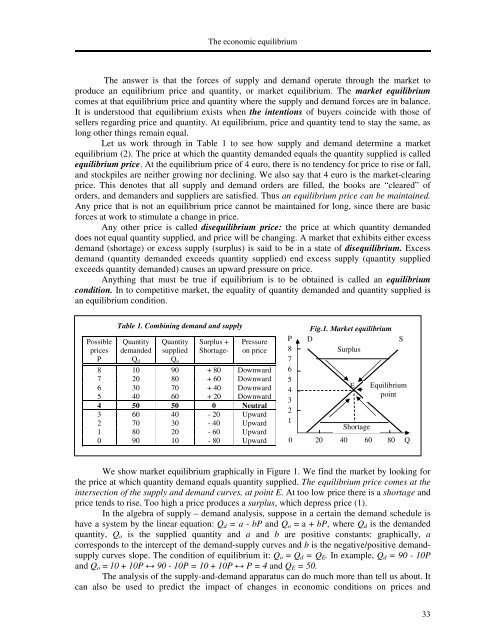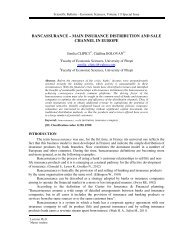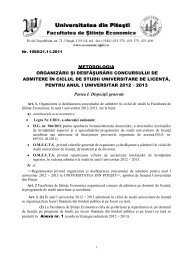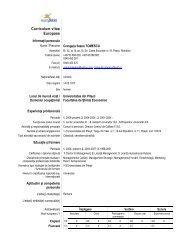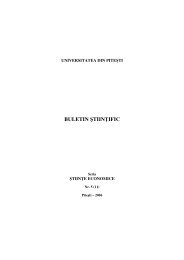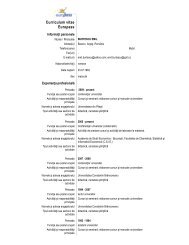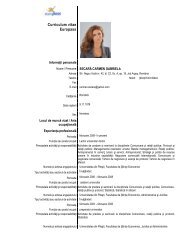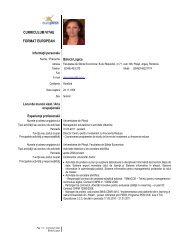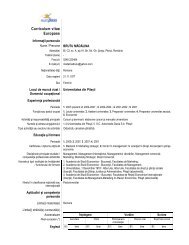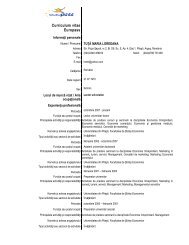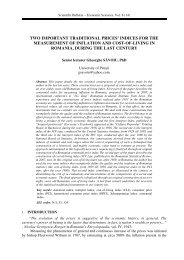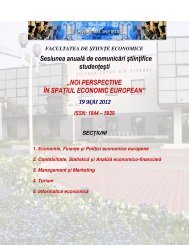buletin Åtiin ific - Facultatea de Stiinte Economice - Universitatea din ...
buletin Åtiin ific - Facultatea de Stiinte Economice - Universitatea din ...
buletin Åtiin ific - Facultatea de Stiinte Economice - Universitatea din ...
- No tags were found...
Create successful ePaper yourself
Turn your PDF publications into a flip-book with our unique Google optimized e-Paper software.
The economic equilibriumThe answer is that the forces of supply and <strong>de</strong>mand operate through the market toproduce an equilibrium price and quantity, or market equilibrium. The market equilibriumcomes at that equilibrium price and quantity where the supply and <strong>de</strong>mand forces are in balance.It is un<strong>de</strong>rstood that equilibrium exists when the intentions of buyers coinci<strong>de</strong> with those ofsellers regar<strong>din</strong>g price and quantity. At equilibrium, price and quantity tend to stay the same, aslong other things remain equal.Let us work through in Table 1 to see how supply and <strong>de</strong>mand <strong>de</strong>termine a marketequilibrium (2). The price at which the quantity <strong>de</strong>man<strong>de</strong>d equals the quantity supplied is calle<strong>de</strong>quilibrium price. At the equilibrium price of 4 euro, there is no ten<strong>de</strong>ncy for price to rise or fall,and stockpiles are neither growing nor <strong>de</strong>clining. We also say that 4 euro is the market-clearingprice. This <strong>de</strong>notes that all supply and <strong>de</strong>mand or<strong>de</strong>rs are filled, the books are “cleared” ofor<strong>de</strong>rs, and <strong>de</strong>man<strong>de</strong>rs and suppliers are satisfied. Thus an equilibrium price can be maintained.Any price that is not an equilibrium price cannot be maintained for long, since there are basicforces at work to stimulate a change in price.Any other price is called disequilibrium price: the price at which quantity <strong>de</strong>man<strong>de</strong>ddoes not equal quantity supplied, and price will be changing. A market that exhibits either excess<strong>de</strong>mand (shortage) or excess supply (surplus) is said to be in a state of disequilibrium. Excess<strong>de</strong>mand (quantity <strong>de</strong>man<strong>de</strong>d exceeds quantity supplied) end excess supply (quantity supplie<strong>de</strong>xceeds quantity <strong>de</strong>man<strong>de</strong>d) causes an upward pressure on price.Anything that must be true if equilibrium is to be obtained is called an equilibriumcondition. In to competitive market, the equality of quantity <strong>de</strong>man<strong>de</strong>d and quantity supplied isan equilibrium condition.PossiblepricesPTable 1. Combining <strong>de</strong>mand and supplyQuantity<strong>de</strong>man<strong>de</strong>dQ dQuantitysuppliedQ oSurplus +Shortage-Pressureon price8 10 90 + 80 Downward7 20 80 + 60 Downward6 30 70 + 40 Downward5 40 60 + 20 Downward4 50 50 0 Neutral3 60 40 - 20 Upward2 70 30 - 40 Upward1 80 20 - 60 Upward0 90 10 - 80 UpwardP87654321Fig.1. Market equilibriumDSurplusEShortageSEquilibriumpoint0 20 40 60 80 QWe show market equilibrium graphically in Figure 1. We find the market by looking forthe price at which quantity <strong>de</strong>mand equals quantity supplied. The equilibrium price comes at theintersection of the supply and <strong>de</strong>mand curves, at point E. At too low price there is a shortage andprice tends to rise. Too high a price produces a surplus, which <strong>de</strong>press price (1).In the algebra of supply – <strong>de</strong>mand analysis, suppose in a certain the <strong>de</strong>mand schedule ishave a system by the linear equation: Q d = a - bP and Q o = a + bP, where Q d is the <strong>de</strong>man<strong>de</strong>dquantity, Q o is the supplied quantity and a and b are positive constants: graphically, acorresponds to the intercept of the <strong>de</strong>mand-supply curves and b is the negative/positive <strong>de</strong>mandsupplycurves slope. The condition of equilibrium it: Q o = Q d = Q E . In example, Q d = 90 - 10Pand Q o = 10 + 10P ↔ 90 - 10P = 10 + 10P ↔ P = 4 and Q E = 50.The analysis of the supply-and-<strong>de</strong>mand apparatus can do much more than tell us about. Itcan also be used to predict the impact of changes in economic conditions on prices and33


